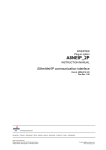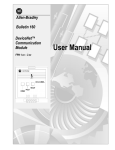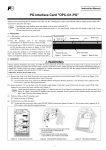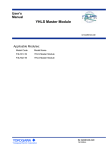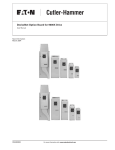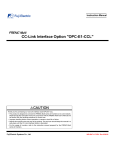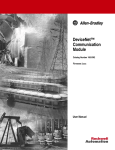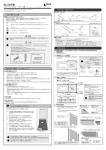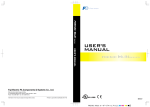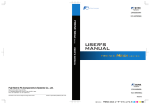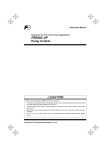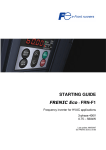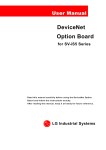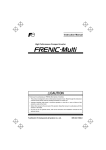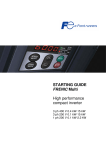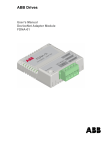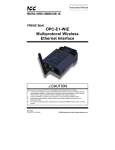Download DeviceNet Interface Option "OPC-E1-DEV"
Transcript
Instruction Manual DeviceNet Interface Option "OPC-E1-DEV" Thank you for purchasing our DeviceNet Interface Option OPC-E1-DEV. • This product is designed to connect the FRENIC-Multi series of inverters to DeviceNet. Read through this instruction manual and be familiar with the handling procedure for correct use. • Improper handling blocks correct operation or causes a short life or failure. • Deliver this manual to the end user of the product. The end user should keep this manual in a safe place until the DeviceNet Interface Option is discarded. • For the usage of inverters, refer to the instruction manual prepared for the FRENIC-Multi series of inverters. Fuji Electric FA Components & Systems Co., Ltd. Copyright © 2006 Fuji Electric FA Components & Systems Co., Ltd. All rights reserved. No part of this publication may be reproduced or copied without prior written permission from Fuji Electric FA Components & Systems Co., Ltd. All products and company names mentioned in this manual are trademarks or registered trademarks of their respective holders. The information contained herein is subject to change without prior notice for improvement. Preface Thank you for purchasing our DeviceNet Interface Option OPC-E1-DEV. Mounting this option on your FRENIC-Multi allows you to connect the FRENIC-Multi to a DeviceNet master unit (e.g., PC and PLC) and control it as a slave unit using the run command, speed command, and access to function codes. This option has the following features: • Data Rate (baud rate): 125 kbps, 250 kbps, 500 kbps • I/O Message: Polling and Change of State supported • Applicable Profile: AC Drive profile • Reading and writing all the function codes applicable to the FRENIC-Multi (User Defined Assembly I/O or Explicit Message) This product has been tested by ODVA authorized Independent Test Lab and found to comply with ODVA’s DeviceNet Conformance Test Version 18. Certification Logo Mark: DeviceNet is a trademark of Open DeviceNet Vendor Association, Inc. (ODVA). This instruction manual does not contain inverter handling instructions. Read through this instruction manual in conjunction with the FRENIC-Multi Instruction Manual (INR-SI47-1094-E) and be familiar with proper handling and operation of this product. Improper handling might result in incorrect operation, a short life, or even a failure of this product. Keep this manual in a safe place. Related Publications Listed below are the other materials related to the use of the DeviceNet interface option "OPC-E1-DEV." Read them in conjunction with this manual as necessary. • RS-485 Communication User's Manual (MEH448) • FRENIC-Multi Instruction Manual (INR-SI47-1094-E) The materials are subject to change without notice. Be sure to obtain the latest editions for use. Safety precautions Read this manual thoroughly before proceeding with installation, connections (wiring), operation, or maintenance and inspection. Ensure you have sound knowledge of the device and familiarize yourself with all safety information and precautions before proceeding to operate the inverter. Safety precautions are classified into the following two categories in this manual. Failure to heed the information indicated by this symbol may lead to dangerous conditions, possibly resulting in death or serious bodily injuries. Failure to heed the information indicated by this symbol may lead to dangerous conditions, possibly resulting in minor or light bodily injuries and/or substantial property damage. Failure to heed the information contained under the CAUTION title can also result in serious consequences. These safety precautions are of utmost importance and must be observed at all times. 1 Installation and wiring • Turn the inverter's power OFF and wait for at least five minutes. Further, check that the DC link bus voltage between the P (+) and N (-) terminals is lower than 25 VDC. • Qualified electricians should carry out wiring. Otherwise, electric shock could occur. • Do not use the product that is damaged or lacking parts. Doing so could cause a fire, accident, or injury. • Prevent lint, paper fibers, sawdust, dust, metallic chips, or other foreign materials from getting into the inverter and the option. Otherwise, a fire or an accident might result. • Incorrect handling in installation/removal jobs could cause a failure. A failure might result. • Noise may be emitted from the inverter, motor and wires. Implement appropriate measure to prevent the nearby sensors and devices from malfunctioning due to such noise. Otherwise, an accident could occur. Operation • Be sure to install the terminal block cover, front cover of the inverter and option terminal cover before turning the inverter's power ON. Do not remove the covers while power is applied. Otherwise electric shock could occur. • Do not operate switches with wet hands. Doing so could cause electric shock. • If you set the function codes wrongly or without completely understanding FRENIC-Multi Instruction Manual (INR-SI47-1094-E) and the FRENIC-Multi User's Manual (MEH457), the motor may rotate with a torque or at a speed not permitted for the machine. Confirm and adjust the setting of the function codes before running the inverter. Otherwise, an accident could occur. Maintenance and inspection, and parts replacement • Turn the inverter's power OFF and wait for at least five minutes before starting inspection. Further, check that the DC link bus voltage between the P (+) and N (-) terminals is lower than 25 VDC. Otherwise, electric shock could occur. • Maintenance, inspection, and parts replacement should be made only by qualified persons. • Take off the watch, rings and other metallic objects before starting work. • Use insulated tools. Otherwise, electric shock or injuries could occur. 2 Disposal • Treat the DeviceNet interface option as an industrial waste when disposing of it. Otherwise injuries could occur. Others • Never attempt to modify the DeviceNet interface option. Doing so could cause electric shock or injuries. How this manual is organized This manual is made up of chapters 1 through 12. Chapter 1 BEFORE USING THIS OPTION Lists points to be checked upon delivery of this option. Also this chapter provides information on how to obtain an EDS file, and describes about applicable inverters. Chapter 2 BASIC FUNCTIONS AND SETTINGS Provides inside view of this option and describes on how to specify the communication data rate (baud rate) and the node address on DeviceNet with the DIP switch. Also this chapter describes about LED status indicators. Chapter 3 INSTALLATION OF THIS OPTION Provides instructions and precautions for mounting this option. Chapter 4 WIRING AND CABLING Provides wiring instructions around the terminal blocks on this option and the cable specifications. Chapter 5 CONFIGURING INVERTER'S FUNCTION CODES FOR DeviceNet COMMUNICATION Describes the inverter's function codes to be set for the DeviceNet communications link. Also this chapter lists the related function codes. Chapter 6 ESTABLISHING A DeviceNet COMMUNICATIONS LINK Guides you to establish a DeviceNet communications link between the DeviceNet master and the inverter. Chapter 7 I/O MESSAGE Provides overview of I/O Message and detailed descriptions of I/O assembly instances Chapter 8 EXPLICIT MESSAGE Provides overview of Explicit Message and detailed descriptions of objects Chapter 9 INVERTER REACTION TO DeviceNet COMMUNICATIONS ERRORS Describes on how the inverter operates if a DeviceNet communications error occurs. Chapter 10 ALARM CODE LIST Lists and explains inverter’s alarm codes. Chapter 11 TROUBLESHOOTING Provides troubleshooting instructions for certain problems, e.g., when the inverter does not operate as ordered or when an alarm condition has been recognized. Chapter 12 SPECIFICATIONS Lists the general specifications and communications specifications. 3 Icons The following icons are used throughout this manual. This icon indicates information which, if not heeded, can result in the product not operating to full efficiency, as well as information concerning incorrect operations and settings which can result in accidents. This icon indicates information that can prove handy when performing certain settings or operations. This icon indicates a reference to more detailed information. Table of Contents Preface ...................................................................................1 How this manual is organized.....................................................3 Chapter 7 I/O MESSAGE ................................................ 19 7.1 Overview ............................................................... 19 7.2 I/O Assembly Instances: Selection and Setup ....... 20 7.3 An Example of Actual I/O Communication Data .... 24 7.4 I/O Assembly Instances Assigned to Word Variables (For reference) ....................................... 26 Chapter 1 BEFORE USING THIS OPTION ....................... 5 1.1 Acceptance Inspection ............................................ 5 1.2 Applicable Inverters ................................................. 5 Chapter 2 BASIC FUNCTIONS AND SETTINGS .............. 6 2.1 DeviceNet Interface Option Inside View .................. 6 2.2 DIP Switch ............................................................... 6 2.3 LED Status Indicators .............................................. 7 2.4 RJ-45 Connector ..................................................... 8 2.5 Power Supply Terminal Block and DeviceNet Terminal Block ......................................................... 8 Chapter 8 EXPLICIT MESSAGE ..................................... 28 8.1 Overview ............................................................... 28 8.2 Objects to be Used in Explicit Message................. 28 8.3 Error Code List for Explicit Message Errors........... 33 Chapter 3 INSTALLATION OF THIS OPTION ................... 9 Chapter 10 ALARM CODE LIST........................................ 35 Chapter 4 WIRING AND CABLING ................................. 13 4.1 Basic Connection Diagram .................................... 13 4.2 Wiring for Power Supply Terminal Block................ 14 4.3 Wiring for DeviceNet Terminal Block ..................... 15 4.4 Turning ON the Optional 24 V Power Supply ........ 16 Chapter 11 TROUBLESHOOTING.................................... 36 Chapter 9 INVERTER REACTION TO DeviceNet COMMUNICATIONS ERRORS ...................... 34 Chapter 12 SPECIFICATIONS .......................................... 37 12.1 General Specifications........................................... 37 12.2 DeviceNet Specifications ....................................... 37 Chapter 5 CONFIGURING INVERTER'S FUNCTION CODES FOR DeviceNet COMMUNICATION . 17 Chapter 6 ESTABLISHING A DeviceNet COMMUNICATIONS LINK ............................. 18 4 Chapter 1 BEFORE USING THIS OPTION 1.1 Acceptance Inspection Unpack the package and check the following: (1) A DeviceNet interface option and accessories below are contained in the package. (See Figure 1.1.) • Two option connection cables One short cable: For inverters with a capacity of 3.7 kW or below One long cable: For inverters with a capacity of 5.5 kW or above • One option fixing screw • DeviceNet Interface Option Instruction Manual (this manual) (2) The option and accessories have not been damaged during transportation—there should be no dents or parts missing. (3) The model name "OPC-E1-DEV" is printed on the nameplate attached to the right side of the option. (See Figure 1.1.) If you suspect the product is not working properly or if you have any questions about your product, contact your Fuji Electric representative. Figure 1.1 DeviceNet Interface Option and Accessories Neither an EDS file nor a terminating resistor comes with this option. - An EDS file is required for registering this option to the configurator for DeviceNet master node settings. It is available as a free download from our website at: http://web1.fujielectric.co.jp/Kiki-Info-EN/User/index.html (Fuji Electric FA Components & Systems Co., Ltd. Technical Information) Before downloading, you are requested to register as a member (free of charge). - A terminating resistor of the following specifications must be used: 121 ohm ±1%, 1/4 watt, metal-film resistor 1.2 Applicable Inverters The DeviceNet interface option is applicable to the following inverters and ROM version. Table 1.1 Applicable inverter and ROM version Series Inverter type Applicable motor rating ROM version FRENIC-Multi FRNE1- All capacities 0700 or later To check the inverter's ROM version, use Menu #5 "Maintenance Information" on the keypad. (Refer to the FRENIC-Multi Instruction Manual (INR-SI47-1094-E), Chapter 3, Section 3.4.6 "Reading maintenance information." Display on LED Monitor Item 5_14 Inverter's ROM version Description Shows the inverter's ROM version as a 4-digit code. 5 Chapter 2 BASIC FUNCTIONS AND SETTINGS 2.1 DeviceNet Interface Option Inside View Figure 2.1 shows the inside view of the DeviceNet interface option with the option terminal cover (See Figure 3.3) removed. Figure 2.1 DeviceNet Interface Option Inside View 2.2 DIP Switch The DIP switch specifies the communication data rate (baud rate) and the node address (MAC ID) on DeviceNet. It offers a choice of three baud rates (125 kbps, 250 kbps, and 500 kbps) and a choice of node address (MAC ID) ranging from 0 to 63. Before accessing the DIP switch, make sure that both the inverter and the option are turned OFF. If you change the configuration of the DIP switch with the inverter and the option being ON, you need to restart both the inverter and the option to validate the new settings. The default settings of the DIP switch at factory shipment are: data rate = 500 kbps, node address = 63. ON OFF 1 2 Data Rate (DR) Figure 2.2 3 4 5 6 Node Address (NA) 7 8 DR (bps) DIP 1-2 125K 00 250K 01 500K 10 Not allowed 11 NA DIP 3-8 0 000000 1 000001 2 000010 3 000011 … … 62 111110 63 111111 DIP Switch Settings (showing an example of Data Rate = 500 kbps and Node Address = 63) 6 2.3 LED Status Indicators The two LED status indicators show the status of this option. - MS (Module Status) Indicates the hardware status of the DeviceNet interface option. - NS (Network Status) Indicates the communication status on DeviceNet. The tables below show the states of the LEDs and their meanings. Table 2.1 MS LED MS LED state Status Meaning Note Blinks between green and red*1 Self-diagnostic test Running self-diagnostic test upon power-on This test takes 1 second. OFF Power OFF Powered OFF The inverter issues er4. Lights in green Hardware normal Hardware working normally Lights in red Hardware error Option not properly mounted or the option is faulty – The inverter issues er4. Table 2.2 NS LED state NS LED Status Meaning Blinks between green and red*1 Self-diagnostic test Running self-diagnostic test upon power-on OFF Offline DeviceNet being offline Blinks in green Online DeviceNet cabling correct Option not communicating on the DeviceNet network Lights in green Connection established Option communicating normally on the DeviceNet network Blinks in red Connection timeout Connection timeout between the option and the master - Too short communication cycle time Note This test takes 1 second. – Waiting for a request from the master – The inverter issues er5 *2 Improper DeviceNet cabling, or improper settings Lights in red Connection error - Node address double assigned - Data rate mismatch - Bus-off state detected - Power supply cable for the DeviceNet unconnected - Improper wiring for the DeviceNet terminal block The inverter issues er5 *2 *1 Blinks in the pattern specified in the DeviceNet specifications. *2 er5 cannot be reset until the NS LED comes to stay on in green. A setting for ignoring er5 is also available even if a connection error is detected. For details, refer to Chapter 9, Section 1 "INVERTER REACTION TO DeviceNet COMMUNICATIONS ERRORS." 7 2.4 RJ-45 Connector The RJ-45 connector is used to connect the keypad of the FRENIC-Multi to this option. The keypad can be detached from the option and mounted on a panel wall. For details, refer to the FRENIC-Multi Instruction Manual (INR-SI47-1094-E), Chapter 2, Section 2.4 "Mounting and Connecting a Keypad." 2.5 Power Supply Terminal Block and DeviceNet Terminal Block The power supply terminal block and DeviceNet terminal block are used to connect the 24V power cable and DeviceNet cable, respectively, in order to operate this option. For details, refer to Chapter 4 "WIRING AND CABLING." 8 Chapter 3 INSTALLATION OF THIS OPTION Turn the inverter's power OFF and wait for at least five minutes. Further, check that the DC link bus voltage between the P (+) and N (-) terminals is lower than 25 VDC. Otherwise, electric shock could occur. • Do not use the product that is damaged or lacking parts. Doing so could cause a fire, accident, or injury. • Prevent lint, paper fibers, sawdust, dust, metallic chips, or other foreign materials from getting into the inverter and the option. Otherwise, a fire or an accident might result. • Incorrect handling in installation/removal jobs could cause a failure. A failure might result. When handling this option, take any antistatic measure or hold the plastic parts taking care not to directly touch the circuit board; otherwise, the static electricity charged in your body may damage it. 9 Before mounting the option, perform the wiring for the main circuit terminals and control circuit terminals. (1) Remove the terminal cover from the inverter. Note: For inverters with a capacity of 5.5 to 15 kW, you need to remove the terminal cover fixing screw to remove the terminal cover. For details on how to remove the terminal cover, refer to the FRENIC-Multi Instruction Manual (INR-SI47-1094-E), Chapter 2, Section 2.3 "Wiring." (2) Connect the option connection cable to the CN1 connector on the interface printed circuit board (interface PCB) on the inverter. Use the short cable for inverters with a capacity of 3.7 kW or below, and the long cable for the ones with a capacity of 5.5 kW or above. (3) Mount the terminal cover. For details on how to mount the terminal cover, refer to the FRENIC-Multi Instruction Manual (INR-SI47-1094-E), Chapter 2, Section 2.3 "Wiring." (4) Push the hooks provided on both sides of the keypad and pull the keypad up and out of the inverter. For details on how to remove the keypad, refer to the FRENIC-Multi Instruction Manual (INR-SI47-1094-E), Chapter 2, Section 2.4 "Mounting and Connecting a Keypad." Figure 3.1 Connecting the Option Connection Cable to the Interface PCB and Removing the Keypad (For inverters with a capacity of 11 and 15 kW) 10 (5) Mount the option on the inverter, making the RJ-45 connector on the back side of the option engage with the RJ-45 connector on the inverter (to which the keypad had been connected). (6) Connect the keypad to the RJ-45 connector on the front side of the option, then secure the keypad and option to the inverter with the option fixing screw (that comes with the option). When using the keypad at a remote site, secure the option without the keypad to the inverter with the screw. Tightening torque: 0.6 N·m Take care not to tighten the option fixing screw too much. Doing so could make the screw defective. Figure 3.2 Mounting the DeviceNet Interface Option and the Keypad 11 (7) Slightly pull the bottom of the option terminal cover towards you and remove it downward. (8) Connect the other end of the option connection cable (whose end has been connected to the interface PCB on the inverter in step (2) above) to the CN1 connector on the interface option printed circuit board (interface option PCB). (9) Mount the option terminal cover. First fit the bosses on the top of the cover into the square holes provided in the option, and then push the bottom of the cover until it snaps into place. Figure 3.3 Connecting the Option Connection Cable to the Interface Option PCB 12 Chapter 4 WIRING AND CABLING • Before starting installation, turn off the power to the inverter and wait for at least five minutes. Further, check the DC link circuit voltage between the P (+) and N (-) terminals to be lower than 25 VDC. • Qualified electricians should carry out wiring. Otherwise, electric shock could occur. The inverter, motor, and wiring emit electrical noise. Take appropriate measures to prevent the nearby sensors and devices from malfunctioning due to such noise. Otherwise, an accident could occur. 4.1 Basic Connection Diagram FRENIC-Multi L1/R U Motor L2/S V M L3/T W PLC G +DC24V CM 0V OPC-E1-DEV Power supply terminal block 24V DeviceNet terminal block DeviceNet cable V- 0V CAN L E Shield CAN H V+ G Grounding terminal Figure 4.1 Basic Connection Diagram 13 To DeviceNet 4.2 Wiring for Power Supply Terminal Block This terminal block is used to supply this option with 24 V power to operate it. Perform wiring for the terminal block as described blow. (1) Wiring for the power supply terminal block (TERM3) The terminal block uses a pluggable 3-pin connector as shown in Figure 4.2. Table 4.1 shows the pin assignment. A typical connector that matches this terminal block is Phoenix Contact MSTB 2.5/3-ST-5.08. Table 4.1 Pin # Terminal name Pin Assignment on Power Supply Terminal Block Description 1 24V Power supply (24 VDC, + side) 2 0V Power supply (24 VDC, - side) 3 E Grounding terminal 1 2 3 Remarks The PLC terminal of the FRENIC-Multi is available as a 24V power source. Connect the PLC terminal to this "24V" terminal and CM terminal to this "0V" terminal. Connect the ground terminal of the inverter ( G) to this terminal. Figure 4.2 Connectors on the Power Supply Terminal Block For protection against external noise and prevention of failures, be sure to connect a grounding wire. Table 4.2 lists the recommended wire size, terminal screw size and its tightening torque. Table 4.2 Recommended Wire Size, Terminal Screw Size, and Its Tightening Torque for the Power Supply Terminal Block Wire size Terminal screw size Tightening torque M3 0.5 to 0.6 N・m 2 AWG20 to AWG16 (0.5 to 1.5mm ), wire with rated temperature 105 °C (UL) recommended Approx. Cable wire 電線 Figure 4.3 6.06mm mm 約 Recommended Strip Length of the Cable Wire End for Terminal Connection 14 (2) Input power requirements It is recommended that the PLC and CM terminals on the FRENIC-Multi be used for the power supply terminal block. When using an external power source, however, select the input power supply that meets the specifications listed in Table 4.3. Table 4.3 Input Power Requirements Item Specifications Input power voltage range 21.6 to 27.0 V Power consumption Maximum 35 mA Do not use the 24 V power supply designed for DeviceNet communication (i.e., power supply fed to the DeviceNet cable) for the power supply terminal block. Doing so may affect negatively on the noise resistance in DeviceNet communication. It is convenient to use the PLC terminal on the control circuit terminal block on the FRENIC-Multi as a 24 V power supply. Connect the PLC terminal to the "24 V" terminal of this option, and the CM terminal, to the "0 V" terminal. For details about the PLC and CM terminals, refer to the FRENIC-Multi Instruction Manual (INR-SI47-1094-E), Chapter 2, Section 2.3 "Wiring." 4.3 Wiring for DeviceNet Terminal Block (1) To connect this option to DeviceNet, use a DeviceNet thin cable complying with the DeviceNet specifications. Also observe the wiring lengths specified in the DeviceNet specifications. The recommended DeviceNet cable is TDN24U made by SWCC Showa Device Technology, Co., Ltd. Proper installation of the cable requires specialist knowledge. Be sure to refer to the DeviceNet specifications (published by ODVA) beforehand. (2) Wiring around the DeviceNet terminal block (TERM1) The terminal block uses a pluggable 5-pin connector as shown in Figure 4.4. It has five labels corresponding to the five pins. Each label has an ID color corresponding to the wire (core) to be connected to its pin. Make sure that the ID colors of the wires and labels match. Table 4.4 shows the correspondence between the pin numbers and the ID colors. A typical connector that matches this terminal block is Phoenix Contact MSTB 2.5/5-ST-5.08 AU. The Phoenix Contact TMSTBP 2.5/5-ST-5.08 AU and TFKC 2.5/5-STF-5.08 AU (spring-cage connection type) connectors for multidrop connection are also usable. Note that, however, the former can be used only for FRENIC-Multi 3.7 kW or below. Table 4.4 Layout of Terminal Pins ID Color of Wire Sheath Pin Assignment 1 Black V- 2 Blue CANL Signal line (- side) 3 Metallic SD Cable shield 4 White CANH Signal line (+ side) 5 Red V+ Power supply (24 VDC, + side) Pin # Description 1 2 3 4 5 Power supply (24 VDC, - side) Figure 4.4 15 Connectors on the DeviceNet Terminal Block Table 4.5 lists the recommended terminal screw size and its tightening torque, and Figure 4.5 shows the recommended strip length of the cable wire end. Approx. Table 4.5 Recommended Tightening Torque of the Terminal Screws for the DeviceNet Terminal Block Terminal screw size M3 Cable wire 電線 約 6.06mm mm Tightening torque 0.5 to 0.6 N·m Figure 4.5 Recommended Strip Length of the Cable Wire End for Terminal Connection (3) Terminating resistor DeviceNet requires a terminating resistor to be installed externally on each end of the trunk line. Check that the trunk line is terminated on both ends; if not, install a terminating resistor(s) on the missing end(s). Terminating resistors do not come with this option. A pair of resistors with the following specifications is separately necessary. 121 ohm ±1%, 1/4 watt, metal-film resistor 4.4 Turning ON the Optional 24 V Power Supply Observe the following instructions about the ON/OFF timing of this option and the inverter. (1) Power ON It is recommended that this option be turned ON at the same time as or before the inverter. Turning the inverter ON first may detect no operation of the option, causing a trip with er4 alarm. The er4 trip can be reset after this option is turned ON. (2) Power OFF It is recommended that this option be turned OFF at the same time as or after the inverter. Turning the option OFF first may cause the inverter to detect no operation of the option, causing a trip with er4 alarm. Turning the inverter OFF resets the er4 trip. When the PLC terminal on the FRENIC-Multi control circuit terminal block is used as a 24V power source, turning ON or OFF of the inverter interlocks with that of the option. It is convenient. 16 Chapter 5 CONFIGURING INVERTER'S FUNCTION CODES FOR DeviceNet COMMUNICATION Before starting DeviceNet communication between the inverter equipped with this option and the DeviceNet master device, configure the inverter's function codes listed in Table 5.1. Table 5.2 lists other related function codes to be configured if necessary. Table 5.1 Function codes o31 *1 Inverter's Function Codes for DeviceNet Communication Factory default setting Description Select output assembly instance 0 (From master to slave) o32 *1 Select input assembly instance 0 (From slave to master) y98 *2 Select run/frequency command source 0 Function code data Remarks Available data is: 20 : Basic speed control output 0, 21 : Extended speed control output 100 : Fuji drive assembly output 102 : User defined assembly output See Chapter 7. Available data is: 70 : Basic speed control input 0, 71 : Extended speed control input 101 : Fuji drive assembly input 103 : User defined assembly input See Chapter 7. Available data is: If there is no special problem with your system, setting y98 = 3 is recommended. 0 1 2 3 Frequency command Run command Inverter DeviceNet Inverter DeviceNet Inverter Inverter DeviceNet DeviceNet The factory default is "Extended speed control output." The factory default is "Extended speed control input." *1 After configuring the function code o31 or o32, turn the power of the inverter and the option OFF and then ON to validate the new setting. For details about these functions, refer to Chapter 7 "I/O MESSAGE." Input and output assembly instances should not be necessarily set to the same instance type. (Ex. Output assembly instance = Extended speed control output, Input assembly instance = User defined assembly input.) *2 If the extended speed control input/output is selected (o31 = 0 or 21), bit operation in the instance can select the run/frequency command source, requiring no prior configuration of y98. For details, refer to Chapter 7, Section 7.2 "(2) Extended Speed Control Instance." Table 5.2 Function codes Other Related Function Codes Description Factory default setting Function code setting range Remarks o27 *1 Select the inverter’s operation mode to apply when a DeviceNet communications error occurs. 0 0 to 15 o28 *1 Set the operation timer to apply when a DeviceNet communications error occurs. 0.0 s 0.0 to 60.0 s o40 to o43 Assign the function code writing data *2 cyclically. 0 (No assignment) o48 to o51 Assign the function code reading data *2 cyclically. 0 (No assignment) 0000 to FFFF (hex) Valid only when "User defined assembly 0000 to FFFF (hex) input/output" is selected (o31 = 102, o32 = 103). *1 For details about function codes o27 and o28, refer to Chapter 9 "INVERTER REACTION TO DeviceNet COMMUNICATIONS ERRORS." *2 For details about function codes o40 to o43 and o48 to o51, refer to Chapter 7, Section 7.2 (4) "User Defined Assembly Instance." 17 Chapter 6 ESTABLISHING A DeviceNet COMMUNICATIONS LINK This chapter guides you to establish a DeviceNet communications link in I/O Message transmission between the DeviceNet master and the inverter (slave). I/O Message is a communication process that cyclically transfers data between the DeviceNet master and slave. For details about I/O Message, refer to Chapter 7, "I/O MESSAGE." (1) Configure the inverter's function codes described in Chapter 5. - Set the I/O assembly instances with the inverter's function codes o31 and o32. It is not necessary to set the same type of I/O assembly instances to input and output. - Configure the inverter's function codes o27 and o28 with your need. If the instances for user defined assemblies have been set, configure the function codes o40 to o43 and o48 to o51. - After completion of the settings above, restart the inverter and this option in order to validate the settings. For details about the inverter's function codes o31, o32, o40 to o43, and o48 to o51, refer to Chapter 7 "I/O MESSAGE." (2) Set up the DeviceNet master (PLC, PC tool, or Configurator). - Set a unique MAC ID (node address), so that it does not coincide with any other nodes. - Set the baud rate. Make sure that all the nodes have the same baud rate. - If necessary, install the EDS file of this option to the setup tool of the master. - Allocate an I/O area corresponding to the I/O assembly instance set for this option. The I/O area is either 2 words or 4 words in length. - Specify the I/O connection type--"Poll" or "Change of state." Specify the communications scan cycle if necessary. The communications scan cycle to this option should be 10 ms or longer. If a single slave is connected to a master, the cycle should be 10 ms or longer; if two slaves are connected, 5 ms or longer. To minimize the data conflicts and maximize the system reliability, the cycle of 20 ms or longer is recommended. The Electric Data Sheet (EDS) file defines parameters on the slave. Using it quickly accesses the desired parameters. For this option, the file makes it easier to access the inverter's function codes. For how to obtain the EDS file, refer to Chapter 2 "Acceptance Inspection." For details about the setup procedure of the DeviceNet master, refer to the user’s manual of the corresponding master. (3) Configure the node address and baud rate with the DIP switch on this option. - Before accessing the DIP switch, make sure that both the inverter and this option are turned OFF. - Set a unique node address, so that it does not coincide with any other nodes. - Set the same baud rate as the master. For details about setting the DIP switch, refer to Section 2.2 "DIP Switch." (4) Have an I/O connection request issued from the DeviceNet master. - Turn ON the inverter and this option. - Have an I/O connection request issued from the DeviceNet master. For details about issuing I/O connection requests from the master, refer to the user's manual of the connected master device. In many PLCs, an I/O connection request is automatically issued at the time of powering ON. (5) Start I/O Message. If both the master and this option have been set correctly and the wiring is proper, I/O message connection will be established in response to the connection request and data transmission starts. At this stage, the MS and NS LEDs on this option light in green. It is ready to control the inverter according to the specified I/O assembly instances. 18 Chapter 7 I/O MESSAGE 7.1 Overview I/O Message is a communication process that cyclically transfers data between the DeviceNet master and slave. This option supports two types of I/O Message connections--Poll and Change-of-State connections. It also supports four types of I/O assembly instances as data formats in I/O Message, as listed in Table 7.1. One of the four instances can be selected for input and output each. The I/O assembly instances should be specified using inverter's function codes o31 and o32. - Poll connections allow the master to periodically poll the slave for data. In response to the request, the slave sends data. In Change-of-State connections, the slave sends data only when the data has changed. - Input and output assembly instances should not be necessarily set to the same instance type. (Ex. Output assembly instance = Extended speed control output, Input assembly instance = User defined assembly input.) Table 7.1 Configuring I/O Assembly Instances Type Instance ID o31=20 Output (from master to slave) 20 Basic Speed Control Output 2 21 Extended Speed Control Output (Factory default) 2 o31=0 or 21 Description Length (words) o31, o32 o31=100 100 Fuji Drive Assembly Output 2 o31=102 102 User Defined Assembly Output 4 70 Basic Speed Control Input 2 71 Extended Speed Control Input (Factory default) 2 o32=101 101 Fuji Drive Assembly Input 2 o32=103 103 User Defined Assembly Input 4 o32=70 o32=0 or 71 Input (from slave to master) 19 7.2 I/O Assembly Instances: Selection and Setup (1) Basic speed control instance Output (from master to this option): o31=20 Instance byte 20 bit 7 bit 6 - bit 5 bit 4 0 - - - 1 (Fixed at 00) 2 Speed Reference (lower byte) (r/min) 3 Speed Reference (upper byte) (r/min) Run Forward: 1 = Run forward command Fault Reset: 1 = Reset the alarm condition bit 3 - bit 2 Fault Reset bit 1 - bit 0 Run Forward Speed Reference: Speed command (in r/min) Input (from this option to master): o32=70 Instance byte 70 0 - bit 7 1 (Fixed at 00) 2 Speed Actual (lower byte) (r/min) 3 Speed Actual (upper byte) (r/min) Faulted: bit 6 - bit 5 - bit 4 - bit 3 - 1 = The inverter has (and remains) tripped Running Forward: 1 = The motor is running forward. Speed Actual: Actual rotation speed (in r/min) 20 bit 2 Running Forward bit 1 - bit 0 Faulted (2) Extended Speed Control Instance (factory default) Output (from master to this option): o31=0 or 21 Instance byte 21 bit 7 bit 6 0 - 1 (Fixed at 00) 2 Speed Reference (lower byte) (r/min) 3 Speed Reference (upper byte) (r/min) Run Forward: NetRef bit 5 NetCtrl bit 4 - bit 3 - bit 2 Fault Reset bit 1 bit 0 Run Reverse Run Forward 1 = Run forward command Run Reverse: 1 = Run reverse command Fault Reset: 1 = Reset the alarm condition NetCtrl: 1 = Request for enabling run command sent from DeviceNet; 0 = Request for enabling run command sent from other than DeviceNet NetRef: 1 = Request for enabling speed reference sent from DeviceNet; 0 = Request for enabling speed reference sent from other than DeviceNet Speed Reference: Speed reference (in r/min) Input (from this option to master): o32=0 or 71 Instance byte 71 bit 7 bit 6 0 At Ref Reference FromNet 1 Drive State bit 5 Ctrl FromNet 2 Speed Actual (lower byte) (r/min) 3 Speed Actual (upper byte) (r/min) Faulted: Running Forward: Running Reverse: Ready: CtrlFromNet: RefFromNet: At Reference: Drive State: Speed Actual: bit 4 Ready bit 3 bit 2 Running Reverse Running Forward bit 1 - 1 = The inverter has (and remains) tripped. 1 = The motor is running forward. 1 = The motor is running backward (in the reverse direction). 1 = Ready to run 1 = Run command sent from DeviceNet being enabled 0 = Run command sent from other than DeviceNet being enabled 1 = Speed reference sent from DeviceNet being enabled 0 = Speed reference sent from other than DeviceNet being enabled 1 = The motor is running at the reference speed. 1 = Startup, 2 = Not Ready, 3 = Ready, 4 = Enabled, 5 = Stopping, 6 = Fault stop, 7 = Faulted Actual rotation speed (in r/min) 21 bit 0 Faulted (3) Fuji Drive Assembly Instance Output (from master to this option): o31=100 Instance byte bit 7 bit 6 bit 5 bit 4 bit 3 bit 2 bit 1 bit 0 100 0 - X5 X4 X3 X2 X1 REV FWD 1 RST XR XF - - - - - 2 Frequency command p.u. (lower byte) 3 Frequency command p.u. (upper byte) FWD: 1 = Run forward command REV: 1 = Run reverse command X1 to X5: Communication terminal block command (The function to be performed is specified by E01 to E05). XF, XR: Communication terminal block command (The function to be performed is specified by E98 and E99). RST: 1 = Reset the alarm (fault) condition. Frequency command p.u.: Specifies the ratio of the frequency relative to the maximum frequency (defined by F03 in Hz) being assumed as 20000. Frequency command p.u. = Frequency command (Hz)/F03 (Hz) × 20000. Input (from this option to master): o32=101 Instance byte bit 7 bit 6 bit 5 bit 4 101 0 VL TL NUV BRK INT EXT REV FWD 1 BUSY ERR - RL ALM DEC ACC IL 2 Frequency output p.u. (lower byte) 3 Frequency output p.u. (upper byte) bit 3 bit 2 bit 1 bit 0 FWD: During forward rotation REV: During reverse rotation EXT: During DC braking (or during pre-exciting) INT: Inverter shut down BRK: During braking NUV: DC link bus voltage established (0 = undervoltage) TL: During torque limiting VL: During voltage limiting IL: During current limiting ACC: During acceleration DEC: During deceleration ALM: Alarm relay (for any fault) RL: Run or speed command from communication enabled ERR: Function code access error BUSY: During function code data writing Frequency output p.u.: Specifies the ratio of the frequency relative to the maximum frequency (defined by F03 in Hz) being assumed as 20000. 22 (4) User Defined Assembly Instance Output (from master to this option): o31=102 User Defined Assembly Output offers a format which allows the user to freely set or modify the function code defined by the user using the function codes o40 to o43 beforehand. Four function codes are provided for the user to define. Instance byte 102 bit 7 bit 6 bit 5 bit 4 bit 3 bit 2 bit 1 0 User-defined function code 1 (write) (lower byte) (data of function code specified by o40) 1 User-defined function code 1 (write) (upper byte) (data of function code specified by o40) 2 User-defined function code 2 (write) (lower byte) (data of function code specified by o41) 3 User-defined function code 2 (write) (upper byte) (data of function code specified by o41) 4 User-defined function code 3 (write) (lower byte) (data of function code specified by o42) 5 User-defined function code 3 (write) (upper byte) (data of function code specified by o42) 6 User-defined function code 4 (write) (lower byte) (data of function code specified by o43) 7 User-defined function code 4 (write) (upper byte) (data of function code specified by o43) bit 0 User-defined function code 1 (write): Write data for the function code specified by o40 User-defined function code 2 (write): Write data for the function code specified by o41 User-defined function code 3 (write): Write data for the function code specified by o42 User-defined function code 4 (write): Write data for the function code specified by o43 If you assign the same function code to more than one "o" code, only the one with the smallest "o" code number will become effective, and all the rest will be ignored (treated as "not assigned"). (For example, if the same function code is assigned to o40 and o43, o40 becomes effective and o43 does not.) For details about configuring the inverter's function codes using o40 to o43, refer to the next page. Input (from this option to master): o32=103 User Defined Assembly Input offers a format which allows the user to monitor the function codes defined by the user using the function codes o48 to o51 beforehand. Four function codes are provided for the user to define. Instance byte 103 bit 7 bit 6 bit 5 bit 4 bit 3 bit 2 bit 1 0 User-defined function code 1 (read) (lower byte) (data of function code specified by o48) 1 User-defined function code 1 (read) (upper byte) (data of function code specified by o48) 2 User-defined function code 2 (read) (lower byte) (data of function code specified by o49) 3 User-defined function code 2 (read) (upper byte) (data of function code specified by o49) 4 User-defined function code 3 (read) (lower byte) (data of function code specified by o50) 5 User-defined function code 3 (read) (upper byte) (data of function code specified by o50) 6 User-defined function code 4 (read) (lower byte) (data of function code specified by o51) 7 User-defined function code 4 (read) (upper byte) (data of function code specified by o51) User-defined function code 1 (read): Monitored value of the function code specified by o48 User-defined function code 2 (read): Monitored value of the function code specified by o49 User-defined function code 3 (read): Monitored value e of the function code specified by o50 User-defined function code 4 (read): Monitored value of the function code specified by o51 bit 0 For details about configuring the inverter's function codes using o48 to o51, refer to the next page. Each function code defined has its own data format. For details about the data format of each code, refer to the RS-485 Communication Use's Manual (MEH448), Chapter 5, Section 5.2 "Data Formats." 23 How to set o40 to o43 and o48 to o51 Specifying the function code type (shown in Table 7.2) and number in a 4-digit hexadecimal notation. Function code number (hexadecimal) Function code type (in accordance with Table 7.2) Table 7.2 Function Code Type Type S Type Code 2 02h Function Code Type Command/function data A Type Code 9 09h Function Code Motor 2 function M 3 03h Monitored data o 10 0Ah Optional function F 4 04h Fundamental function J 14 0Eh Application function E 5 05h Terminal function y 15 0Fh Link function C 6 06h Control function W 16 10h Monitor 2 P 7 07h Motor 1 function X 17 11h Alarm 1 08h High performance function Z 18 12h Alarm 2 H 8 Example: For F26: F ⇒ Type Code 04 26 ⇒ 1A (hexadecimal) 041a Once you have modified the settings for o40 to o43 and o48 to o51, be sure to restart both the inverter and this option in order to validate the new settings. 7.3 An Example of Actual I/O Communication Data Presented herein is an actual communication data in the format of Extended Speed Control Instance, the factory default format. (1) Driving pattern example Given below is an example of the driving pattern for controlling the inverter. Its corresponding I/O data is shown in (2) on the next page. Forward 1800 r/min Time (s) 300 r/min 1800 r/min Reverse Figure 8 Driving Pattern 24 (2) Description of I/O Data (The I/O data are in hexadecimal notation.) Request: Run command is OFF. Speed command = 1800 r/min (= 0708h). The run command and speed command via DeviceNet are enabled. 60 00 08 07 Response: Stopping. The inverter is ready. 70 03 00 00 Request: Run forward command. Speed command = 1800 r/min (= 0708h). The run command and speed command via DeviceNet are enabled. 61 00 08 07 Response: The motor is running forward and accelerating. The actual speed is increasing. 74 04 ** ** Request: Run forward command. Speed command = 1800 r/min (= 0708h). The run command and speed command via DeviceNet are enabled. 61 00 08 07 Response: Running forward. The actual speed has reached the Reference F4 04 08 07 Request: Run command is OFF. Speed command = 1800 r/min (= 0708h). The run command and speed command via DeviceNet are enabled. 60 00 08 07 Response: The motor is running forward and decelerating. The actual speed is decreasing. 74 05 ** ** Request: No run command. Speed command is changed to 300 r/min (= 012Ch). The run command and speed command via DeviceNet are enabled. 60 00 2C 01 Response: Stopping. The inverter is ready. 70 03 00 00 Request: Run reverse command. Speed command = 300 r/min (= 012Ch). The run command and speed command via DeviceNet are enabled. 62 00 2C 01 Response: The motor is running backward (in the reverse direction) and accelerating. The actual speed is increasing. 78 04 ** ** Request: Run reverse command. Speed command = 300 r/min (= 012Ch). The run command and speed command via DeviceNet are enabled. 62 00 2C 01 Response: Running in the reverse direction. The actual speed has reached Reference F8 04 2C 01 Request: Run reverse command. Speed command is changed to 1800 r/min (= 0708h). The run command and speed command via DeviceNet are enabled. 62 00 08 07 Response: The motor is running backward (in the reverse direction) and accelerating. The actual speed is increasing. 78 04 ** ** Request: Run reverse command. Speed command = 1800 r/min (= 0708h). The run command and speed command via DeviceNet are enabled. 62 00 08 07 Response: Running in the reverse direction. The actual speed has reached Reference F8 04 08 07 Request: Run command is OFF. Speed command = 1800 r/min (= 0708h). The run command and speed command via DeviceNet are enabled. 60 00 08 07 Response: The motor is running backward (in the reverse direction) and decelerating. The actual speed is decreasing. 78 05 ** ** 25 7.4 I/O Assembly Instances Assigned to Word Variables (For reference) Some masters assign an I/O assembly instance area to a word variable. Shown below are the formats for each I/O assembly instance assigned to a word variable. For details about the definition of bits in the formats, refer to Section 7.2, "I/O ASSEMBLY INSTANCES: SELECTION AND SETUP." (1) Basic Speed Control Instance Output (from master to this option): o31=20 word 0 1 bit15 14 13 12 11 10 9 8 7 6 5 4 3 2 1 bit0 - - - - - - - - - - - - - Fault Reset - Run Forward Speed Reference (r/min) Input (from this option to master): o32=70 word 0 1 bit15 14 13 12 11 10 9 8 7 6 5 4 3 2 1 - - - - - - - - - - - - - Running Forward - bit0 Faulted Speed Actual (r/min) (2) Extended Speed Control Instance Output (from master to this option): o31=21 word 0 1 bit15 14 13 12 11 10 9 8 7 6 5 4 3 - - - - - - - - - Net Ref Net Ctrl - - 2 Fault Reset 1 bit0 Run Reverse Run Forward Speed Reference (r/min) Input (from this option to master): o32=71 word 0 bit15 14 13 12 11 10 9 8 - - - - - - - - 7 At 6 5 4 3 2 1 bit0 *2 *1 Ready Running Reverse Running Forward - Faulted Reference 1 Speed Actual (r/min) *1 CtrlFromNet *2 RefFromNet (3) Fuji Drive Assembly Instance Output (from master to this option): o31=100 word bit15 14 13 12 11 10 9 8 7 6 5 4 3 2 1 bit0 0 RST XR XF - - - - - - X5 X4 X3 X2 X1 REV FWD 1 Frequency command p.u. Input (from this option to master): o32=101 word bit15 14 13 12 11 10 9 8 7 6 5 4 3 2 1 bit0 0 BUSY ERR - RL ALM DEC ACC IL VL TL NUV BRK INT EXT REV FWD 1 Frequency command p.u. 26 (4) User Defined Assembly Instance Output (from master to this option): o31=102 word bit15 14 13 12 11 10 9 8 7 6 5 0 User-defined function code 1 (write) (data of function code specified by o40) 1 User-defined function code 2 (write) (data of function code specified by o41) 2 User-defined function code 3 (write) (data of function code specified by o42) 3 User-defined function code 4 (write) (data of function code specified by o43) 4 3 2 1 bit0 4 3 2 1 bit0 Input (from this option to master): o32=103 word bit15 14 13 12 11 10 9 8 7 6 5 0 User-defined function code 1 (read) (data of function code specified by o48) 1 User-defined function code 2 (read) (data of function code specified by o49) 2 User-defined function code 3 (read) (data of function code specified by o50) 3 User-defined function code 4 (read) (data of function code specified by o51) 27 Chapter 8 EXPLICIT MESSAGE 8.1 Overview Explicit Message is a communication process that accesses DeviceNet variables at arbitrary (event-driven) timing. Using this option is capable of accessing not only standard DeviceNet variables but also all inverter's function codes. Explicit Message lacks realtime performance, but it allows many variables to be set or referred to. It is, therefore, suited for initial setting. Refer to the user's manual of the connected master for Explicit Message. - Variables usable in Explicit Message are grouped using three codes--Class (major key), Instance (medium key) and Attribute (minor key). These three codes should be used for specifying a variable. - A group of all variables contained in Class is called "Object." 8.2 Objects to be Used in Explicit Message This section describes objects relating to this option and the inverter. Other objects that are automatically executed by the master device are excluded in this manual. (1) Identity object (Class 01 hex.) This object refers to the product information of this option. It is a group of read-only variables. Instance R/W Data size 0 Attribute 01 Revision Name Revision number of Identity 0001 object Description Value (hex.) R Word 1 01 Vender ID Manufacturer's ID code 013F (=319): Fuji Electric R Word 02 Device Type Applied device profile 0002: AC drive R Word 03 Product Code ID code of this option 2402 R Word 04 Revision Software version (Major and minor versions) Display of version Example: 01, 0A (=Ver. 1.10) R Byte, Byte 05 Status Status of this option Depends on DeviceNet specifications. R Word 06 Serial Number Serial number of the product Differs with the product. R DWord 07 Product Name Model name OPC-E1-DEV R 11 bytes (2) Motor Data object (Class 28 hex.) This object refers to and sets up the motor rated current and voltage. When Motor 2 is selected, this object automatically switches to the one for Motor 2. Instance Attribute R/W Data size 0 01 Revision Name Revision number of Motor Data object Description 0001 R Word 1 03 Motor Type Type of motor connected 07: Squirrel-cage, induction motor R Byte 06 Rated Current Rated current in units of 0.1 A Depends on the inverter setting. R/W Word 07 Rated Voltage Rated voltage in units of 1 V (base voltage) Depends on the inverter setting. R/W Word 28 Value (hex.) (3) Control Supervisor object (Class 29 hex.) This object monitors the current run command settings and the running status of the inverter, and configures the running-related settings. Instance Attribute Name Description Value (hex.) R/W Data size 0 01 Revision Revision number of Control 0001 Supervisor object R Word 1 03 Run1 Run forward command 00: OFF 01: ON R/W Byte 04 Run2 Run reverse command 00: OFF 01: ON R/W Byte 05 NetCtrl Switching run command source 00: Inverter 01: DeviceNet R/W Byte 06 State Current inverter status 01: Inverter running 02: Inverter not ready to run 03: Inverter ready to run 04: Inverter running 05: During deceleration 06: Stop due to communication broken 07: Tripped R Byte 07 Running1 Running forward 00: Stopped/Running reverse 01: Running forward R Byte 08 Running2 Running reverse 00: Stopped/Running forward 01: Running reverse R Byte 09 Ready Inverter ready to run/Inverter running (Synchronized with State above) 00: State = Value except below 01: State = 03 to 05 R Byte 0A Faulted Tripped state 00: Not tripped 01: Tripped R Byte 0B Warning Warning. Fixed at 0. 00: No warning R Byte 0C FaultRst Reset of tripped (alarm) state 00→01: Request for reset R/W Byte 0F CtrlFromNet Current run command source 00: Inverter 01: DeviceNet R Byte 10 DNFaultMode Inverter reaction to DeviceNet Refer to Chapter 9. communications errors R/W Byte 29 (4) AC/DC Drive object (Class 2A hex.) This object monitors the current speed command settings and the current speed of the inverter, and configures their related settings. It also monitors the output data issued from the inverter. Instance Attribute 0 01 hex Revision Name Revision number of AC/DC Drive object Description 0001 Value (hex.) R R/W Data size Word 1 03 hex AtReference Speed arrival 00: Stopped/ Accelerating or decelerating 01: Speed arrival R Byte 04 hex NetRef Switching speed command source 00: Inverter 01: DeviceNet R/W Byte 06 hex DriveMode Run mode. Fixed at 0. 00: Unique to vendor R Byte 07 hex SpeedActual Speed monitor (r/min) Actual speed R Word 08 hex SpeedRef Speed command (r/min) -32768 to 32767 r/min R/W Word 09 hex CurrentActual Output current (in units of 0.1 A) Output current R Word 11 hex OutputVoltage Output voltage (V) Output voltage R Word 12 hex AccelTime Acceleration time (ms) 0 to 65535 ms R/W Word 13 hex DeccelTime Deceleration time (ms) 0 to 65535 ms R/W Word 14 hex LowSpdLimit Lower limit speed (r/min) 0 to 32767 r/min R/W Word 15 hex HighSpdLimit Maximum speed (r/min) 0 to 32767 r/min R/W*1 Word 16 hex SpeedScale Change the speed scale (r/min) all at once, as calculated below. -15 to 15 (Factory default: 0) R/W Byte -15 to 15 (Factory default: 0) R/W Byte -15 to 15 (Factory default: 0) R/W Byte -15 to 15 (Factory default: 0) R/W Byte 00: Inverter 01: DeviceNet R Byte r/min 2 SpeedScale 17 hex CurrentScale Change the current scale (0.1 A) all at once, as calculated below. 0.1 A 2 CurrentSca le 1B hex VoltageScale Change the voltage scale (V) all at once, as calculated below. V 2 VoltageSca le 1C hex TimeScale Change the time scale (ms) all at once, as calculated below. ms 2 TimeScale 1D hex RefFromNet Current speed command source *1 "Read-only" while the inverter is running. 30 (5) Inverter Function Code object (Class 64 hex.) This object configures or refers to inverter's function codes. Instance corresponds to function code group and Attribute, to function code number. Example: To configure F26 data, specify 04 hex for Instance and 1A hex (=26) for Attribute. Inverter's function codes have individually specified data formats. For details about the data formats, refer to the RS-485 Communication User's Manual (MEH448), Chapter 5 "Function Codes and Data Formats." For details about function code data, refer to the FRENIC-Multi Instruction Manual (INR-SI47-1094-E), Chapter 5, "Function Codes." Instance 00 Attribute 01 Name Description Revision Revision number of Function Code object Inverter Value (hex.) R/W Data size 0001 R Word 02 01 S01 Communication function code S01 0 to FFFF R/W Word (S codes) : : : : : : : : : : : : 63 hex (99) S99 Communication function code S99 0 to FFFF R/W Word Communication function code M01 0 to FFFF R Word : : : : : : 0 to FFFF R Word 03 01 M01 (M codes) : : : : 63 hex (99) M99 : : Communication function code M99 04 01 F01 Inverter function code F01 0 to FFFF R/W Word (F codes) : : : : : : : : : : : : Word 63 hex (99) F99 Inverter function code F99 0 to FFFF R/W 05 01 E01 Inverter function code E01 0 to FFFF R/W Word (E codes) : : : : : : : : : : : : 63 hex (99) E99 Inverter function code E99 0 to FFFF R/W Word 06 01 C01 Inverter function code C01 0 to FFFF R/W Word (C codes) : : : : : : : : : : : : Word 63 hex (99) C99 Inverter function code C99 0 to FFFF R/W 07 01 P01 Inverter function code P01 0 to FFFF R/W Word (P codes) : : : : : : : : : : : : 63 hex (99) P99 Inverter function code P99 0 to FFFF R/W Word 08 01 H01 Inverter function code H01 0 to FFFF R/W Word (H codes) : : : : : : : : : : : : 63 hex (99) H99 Inverter function code H99 0 to FFFF R/W Word 09 01 A01 Inverter function code A01 0 to FFFF R/W Word (A codes) : : : : : : : : : : : : 63 hex (99) A99 Inverter function code A99 0 to FFFF R/W Word 0A (10) 01 o01 Option function code o01 0 to FFFF R/W Word (o codes) : : : : : : : : : : : : 63 hex (99) o99 Option function code o99 0 to FFFF R/W Word 0E (14) 01 J01 Inverter function code J01 0 to FFFF R/W Word (J codes) : : : : : : : : : : : : 63 hex (99) J99 Inverter function code J99 0 to FFFF R/W Word 31 Value (hex.) R/W 0F (15) Instance 01 Attribute y01 Name Inverter function code y01 Description 0 to FFFF R/W Data size Word (y codes) : : : : : : : : : : : : 63 hex (99) y99 Inverter function code y99 0 to FFFF R/W Word 10 (16) 01 W01 Communication function code W01 0 to FFFF R Word (W codes) : : : : : : : : : : : : 63 hex (99) W99 Communication function code W99 0 to FFFF R Word 11 (17) 01 X01 Communication function code X01 0 to FFFF R Word (X codes) : : : : : : : : : : : : 63 hex (99) X99 Communication function code X99 0 to FFFF R Word 12 (18) 01 Z01 Communication function code Z01 0 to FFFF R Word (Z codes) : : : : : : : : : : : : 63 hex (99) Z99 Communication function code Z99 0 to FFFF R Word 32 8.3 Error Code List for Explicit Message Errors If an explicit message sent from the master contains any error, this option responds to the master with "94" in the service code and "error code" (see Table 8.1) in the data. An error code is two bytes long, consisting of a general code and additional code. Some error codes have no additional code and have "FF" instead. Table 8.1 Error Code List for Explicit Message Errors Error code Error name Description Error recovery General code Additional code 08 FF Service not supported Invalid service code Correct service code. (Read: 0E hex, Write:10 hex) 0E FF Invalid attribute value Attempted to change a write-inhibited variable. Check the specified variable again. 13 FF Not enough data Attempted to write Byte data to Word variable. Match the data size. 14 FF Attribute not supported Access to a nonexistent variable. Check the specified variable again. 15 FF Too much data Attempted to write Word data to Byte variable. Match the data size. 16 FF Object does not exist Access to a nonexistent object. Correct the contents of the Class. 1F See blow. Vender specific error Error unique to vendor See below. 02 No function code (in writing) Attempted to write to a nonexistent function code. Correct the function number specified. code 03 Function code not allowed to change Attempted to write to a read-only function code. Correct the function number specified. code 06 Not allowed to change in running Attempted to write to a function code not allowed to change when the inverter is running. Write after stopped. 07 Not allowed to change with X terminal being ON Attempted to write to a function code not allowed to change when X terminal is ON. Write after the X terminal is turned OFF. 08 Data entry range error Attempted to write data out of the range. Write data within the range. 0F Function code data being written Requested to write to a function code being written. Request to write after completion of the current writing operation. 21 No function code (in reading) Attempted to read from a nonexistent function code. Correct the function number specified. FF Invalid parameter Attempted to write a value out of the range. Correct the value within the range. 20 33 the inverter is code Chapter 9 INVERTER REACTION TO DeviceNet COMMUNICATIONS ERRORS Inverter's function codes o27 and o28 specify the inverter reaction to be taken after an error occurrence. Table 9.1 lists the settings for o27 and o28. The same setting can also be made by the DeviceNet variable DNFaultMode (Class: 0x29, Instance: 0x01, Attribute: 0x10). Table 9.2 lists the inverter reaction specified by the DNFaultMode. The setting value of o27 and that of DNFaultMode are interlocked with each other. Changing either one automatically changes the other one. Table 9.1 Inverter Reactions to DeviceNet Communications Errors Specified by Function Codes o27 and o28 o27 data o28 data 0, 4 to 9 --- 1 0.0 s to 60.0 s After the time specified by o28, coast to a stop and trip with er5. 2 0.0 s to 60.0 s If the communications link is restored within the time specified by o28, ignore the communications error. After the timeout, coast to a stop and trip with er5. 3, 13 to 15 --- Keep the current operation, ignoring the communications error. (No er5 trip) 10 --- Immediately decelerate to a stop. Issue er5 after stopping. 11 0.0 s to 60.0 s 12 0.0 s to 60.0 s 13 --- Immediately run command OFF. (No er5 trip) 14 --- Force to rotate the motor in forward direction. (No er5 trip) Forward rotation is enabled when NetCtrl = 1. 15 --- Force to rotate the motor in reverse direction. (No er5 trip) Reverse rotation is enabled when NetCtrl = 1. Table 9.2 DNFaultMode Inverter reaction to DeviceNet communications error Remarks Immediately coast to a stop and trip with er5. The inverter's function code F08 specifies the deceleration time. After the time specified by o28, decelerate to a stop. Issue er5 after stopping. If the communications link is restored within the time specified by o28, ignore the communications error. After the timeout, decelerate to a stop and trip with er5. Same as above. Same as above. Inverter Reactions to DeviceNet Communications Errors Specified by DNFaultMode Inverter reaction to DeviceNet communications error Remarks o27 data 0 Immediately run command OFF. (No er5 trip) 1 Ignore the communications error. (No er5 trip) 2 If the communications link is restored within the time specified by o28, ignore the communications error. After the timeout, decelerate to a stop and trip with er5.. The inverter's function code F08 specifies the deceleration time. 12 3 Force to rotate the motor in forward direction. (No er5 trip) Forward rotation is enabled when NetCtrl = 1. 14 4 Force to rotate the motor in reverse direction. (No er5 trip) Reverse rotation is enabled when NetCtrl = 1. 15 100 Immediately coast to a stop and trip with er5. 0 101 After the time specified by o28, coast to a stop and trip with er5. 1 102 If the communications link is restored within the time specified by o28, ignore the communications error. After the timeout, coast to a stop and trip with er5. 2 110 Immediately decelerate to a stop. Issue er5 after stopping. The inverter's function code F08 specifies the deceleration time. 10 111 After the time specified by o28, decelerate to a stop. Issue er5 after stopping. Same as above. 11 112 Same as for [DNFaultMode = 2] 13 3 12 34 Chapter 10 ALARM CODE LIST The information on alarms that have occurred in the inverter can be monitored through DeviceNet. They are stored in the inverter's function codes M16 to M19 as listed in Table 10.1. The communication dedicated function codes M16 to M19 store information on the current alarm code, most recent alarm code, 2nd recent alarm code, and 3rd recent alarm code, respectively. Table 10.1 Alarm Codes Alarm codes in M16 to M19 Alarm codes in M16 to M19 Description Description 0 No alarm --- 22 Braking resistor overheated dbh 1 Overcurrent (during acceleration) 0c1 23 Motor 1 overload 0l1 2 Overcurrent (during deceleration) 0c2 24 Motor 2 overload 0l2 3 Overcurrent (During running at constant speed) 0c3 25 Inverter overload 0lu 5 Ground fault ef 31 Memory error er1 6 Overvoltage (during acceleration) 0u1 32 Keypad communications error er2 7 Overvoltage (during deceleration) 0u2 33 CPU error er3 8 Overvoltage (during running at constant speed (stopped)) 0u3 34 Interface option communications error er4 10 Undervoltage lu 35 DeviceNet communications error er5 11 Input phase loss lIn 36 Operation protection er6 14 Fuse blown fus 37 Tuning error er7 16 Charger circuit fault pbf 38 RS-485 communications error er8 17 Heat sink overheat 0h1 46 Output phase loss 0pl 18 Alarm issued by an external device 0h2 51 Data saving error during undervoltage erf 19 Inverter overheat 0h3 53 RS-485 communications error (option card) erp 20 Motor protection (PTC thermistor) 0h4 54 LSI error (Power printed circuit board) erh 35 Chapter 11 TROUBLESHOOTING If any problem or error occurs during DeviceNet communication, follow the troubleshooting procedures given below. No 1 Phenomenon/Symptom None of the LEDs on the option would light. Probable Causes • No 24 VDC power supply is connected to this option. • The option is faulty. • The option is not properly mounted. 2 er4 alarm cannot be reset (The MS LED lights in red). • The option connection cable is not connected. • The option is faulty. • The same node address is double assigned in DeviceNet. • There is a mismatch in baud (data) rate. 3 The NS LED lights in red. (er5 alarm cannot be reset.) • The network power (24 V) is not properly supplied. • Cabling for DeviceNet communications is not properly done. • The inverter and the option have not been powered OFF and then ON after modifying the DIP switch settings. 4 The NS LED blinks in red. (er5 alarm has occurred.) 5 The NS LED would not light. 6 The NS LED keeps blinking in green and does not come to stay on in green. • The cable was broken during communication. • The I/O scan interval is too short. • The node address for the option is improper. • The cable for DeviceNet communications was broken. • The master does not request a connection. • The I/O scan interval has been set to be too short at the start of communication. • The I/O area is invalidly mapped. • There is no I/O connection. • Neither NetCtrl nor NetRef is set to "1." 7 8 Even though the NS LED lights in green, the settings for run command or speed command cannot be validated. • On the inverter, the higher-priority run command or speed command is enabled. Although the speed command has been validated, the actual speed is different from it. • Refer to the FRENIC-Multi Instruction Manual (INR-SI47-1094-E), Section 6.2.1 "Motor is running abnormally." • There is a mistake in the selection of I/O Assembly Instances. • The inverter and the option have not been powered OFF and then ON after modifying the o31 data. 36 Chapter 12 SPECIFICATIONS 12.1 General Specifications For the items not covered in this section, the specifications of the inverter apply. Item Specifications Power input voltage 21.6 to 27.0 V Input power 35 mA at maximum (24 VDC) (not included network input power) Operating ambient temperature range -10 to +50°C Operating ambient humidity range 5 to 95% RH (There shall be no condensation.) External dimensions 79.6 x 127 x 47.5 mm Applicable inverter FRENIC-Multi, ROM version: 0700 or later 12.2 DeviceNet Specifications For the items not covered in this section, the DeviceNet Specifications Release 2.0 apply. Item Specifications Network input voltage 11 to 28 V Network power consumption 75 mA at maximum (24 VDC) No. of nodes connected 64 at maximum (including the master) MAC ID 0 to 63 Insulation 500 VDC (photocoupler insulation) Transmission rate 500 kbps/250 kbps/125 kbps Maximum cable length Transmission rate (Trunk line: thick cable Drop line: thin cable) Trunk line length Drop line length Total length of drop lines Messages supported 500 kbps 250 kbps 125 kbps 100 m 250 m 500 m 6m 6m 6m 39 m 78 m 156 m 1. I/O Message (Poll, Change of State) 2. Explicit Message Vendor ID 319 (Fuji Electric Co., Ltd.) Device type AC drive (code: 2) Product code 9218 Model name OPC-E1-DEV Applicable device profile AC Drive No. of input/output bytes Selectable between 4 and 8 bytes for input and output (independently) Applicable DeviceNet Specifications DeviceNet Specifications Release 2.0 Errata 5 (Certified by ODVA Japan for Conformance Test Version A-18) Node type Group 2 only server 37 MEMO 38 DeviceNet Interface Option "OPC-E1-DEV" Instruction Manual First Edition, September 2006 Fuji Electric FA Components & Systems Co., Ltd. The purpose of this manual is to provide accurate information in the handling, setting up and operating of DeviceNet Interface Option "OPC-E1-DEV" for the FRENIC-Multi series of inverters. Please feel free to send your comments regarding any errors or omissions you may have found, or any suggestions you may have for generally improving the manual. In no event will Fuji Electric FA Components & Systems Co., Ltd. be liable for any direct or indirect damages resulting from the application of the information in this manual. Fuji Electric FA Components & Systems Co., Ltd. Mitsui Sumitomo Bank Ningyo-cho Bldg., 5-7, Nihonbashi, Odemma-cho, Chuo-ku, Tokyo, 103-0011, Japan Phone: +81 3 5847 8011 Fax: +81 3 5847 8172 URL http://www.fujielectric.co.jp/fcs/ 2006-09 (I06/I06) XXCM











































